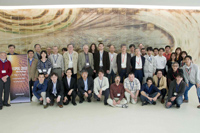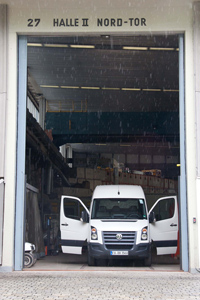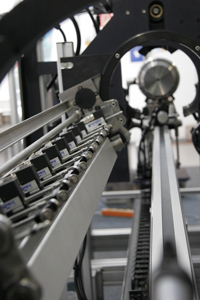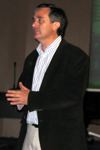 |
|
|
 |
From KEK: The fifth POSIPOL workshop held at KEK

Participants of the POSIPOL 2010 workshop held at KEK |
The POSIPOL 2010 workshop was held from 31 May to 2 June at KEK. It was the fifth in the POSIPOL series of workshops dealing with the physics aspects, the design issues, and the open questions concerning a polarised positron source in the framework of the next-generation electron-positron colliders such as the ILC or the Compact Linear Collider Study CLIC.
A total of 44 scientists from Europe, Asia and the US attended the workshop, including some via videoconference. The main topic of the POSIPOL 2010 was design of the polarised positron sources for the ILC and for CLIC. The only linear accelerator which used a positron beam was the SLAC Linear Collider (SLC) at SLAC National Accelerator Laboratory in the US “For CLIC, we will need to produce 18 times more positrons than SLC, and 65 times more for the ILC”, said Dr. Louis Rinolfi (CERN), who is convener of the ILC/CLIC joint working group for positron studies, “these numbers show how far we are from what where want to be,” Rinolfi said.
Read more...
|
 |
|
|
 |
| Upcoming meetings, conferences, workshops
LoopFest IX: Radiative Corrections for the LHC and Lepton Colliders
Stony Brook University Campus, NY, USA
21 June - 23 June 2010
TeV Particle Astrophysics 2010
Paris, France
19 July - 23 July 2010
35th International Conference on High Energy Physics (ICHEP2010)
Palais des Congrès, Paris, France
21 July - 28 July 2010
First Baseline Assessment Workshop
KEK, Tsukuba, Japan
7-10 September 2010
Upcoming schools
CERN Accelerator School (CAS 2010): Course on RF for Accelerators Ebeltoft, Denmark
8-17 June 2010
Fifth CERN-Fermilab Hadron Collider Physics Summer School
Fermilab, Batavia, IL, USA
16-27 August 2010
|
|
|
GDE Meetings calendar
View complete ILC calendar
|
|
|
 |
A telescope road movie
A story about how everybody can bring science forward

Telescope transport now departing from Halle II. Image: Barbara Warmbein
|
I don't usually start stories for ILC NewsLine with the word 'I'. This time I have to make an exception, because for a change I was not merely a spectator and communicator of science, but a facilitator (of sorts). One of the actors in something both very mundane and very exciting: transporting scientific equipment from one lab to another. On Sunday 30 May, the EUDET beam telescope was brought from DESY to CERN, and I was one of its (three) drivers.
Read more...
-- Barbara Warmbein |
What is it?

To kick off the season of sudokus on the beach, here's a first puzzle for you to solve. What do we see in this picture? How big is it, and what does it do? Send your answer to communicators@linearcollider.org with a short description of what you do – if you're too closely involved you run out of competition.
|
 |
|
|
 |
From Discover Magazine Blog
8 June 2010
World Science Festival: What if Physicists Don't Find the Higgs Boson?
“It's as if we're fish who have suddenly discovered we're in water,” said Nobel Laureate Frank Wilczek about the Large Hadron Collider. “The LHC is the device for ruffling up the waters so that we can see waves...”
Read more... |
|
From Physicsworld.com
8 June 2010
Does dark matter come in two types?
"I think that we have the first model with which we are able to explain essentially all of the current dark-matter data, Pran Nath, Northeastern University"
Read more... |
|
From CERN Bulletin
7 June 2010
Uniting forces in physics and medicine
"Although physics research is at the origin of an increasing number of medical techniques used for the early diagnosis and treatment of tumors and other diseases, the workshop was a novel initiative to bring medical doctors and physicists together to discuss global strategies."
Read more... |
|
From Physicsworld.com
4 June 2010
Earth's random walk could jolt particle accelerators
"...Practical use of the simple equation confirmed by Shiltsev is unlikely to come until new linear accelerators such as the International Linear Collider (ILC) are built. “Ground motion is one of the major factors limiting the predicted performance of future linear particle colliders,”... "
Read more... |
|
|
 |
The latest ILC technical review

Juan Fuster Verdu, IFIC Spain, making introductions at the PAC meeting |
I periodically write about aspects of the review process for our work in the ILC Global Design Effort. Since such reviews represent checkpoints on our progress, independent assessments of our work, and also a mechanism for constructive advice, I feel that sharing some key outcomes is an effective way to inform and include the community. Today, I will report on the latest meeting of the Project Advisory Committee (PAC) that reviews both the accelerator and detector technical efforts and reports to the International Linear Collider Steering Committee (ILCSC). This recent meeting was particularly important, because at this time we are dealing with differing opinions regarding the proposed baseline changes for the ILC technical design.
Read more...
-- Barry Barish
Director's Corner Archive |
 |
|
|
 |
ILC Internal Document
2010-044
ILC Global Design Effort – Project Managers' Report – April 2010
arXiv preprints
1006.1241
Measurement of the Higgs mass via the channel : e+e- → ZH → e+e- + X
1006.1207
Beam-Beam Interaction in Novel, Very High Luminosity Parameter Regimes
1006.1009
Location and Direction Dependent Effects in Collider Physics from Noncommutativity
1006.0436
Treatment of Photon Radiation in Kinematic Fits at Future e+e- Colliders
1006.0090
Gallium Arsenide preparation and QE Lifetime Studies using the ALICE Photocathode Preparation Facility
1006.0086
High Gradient Superconducting Cavity with Low Surface EM Fields and Well-Suppressed HOMS for the ILC
1005.5323
A Leptophilic Model Explaining Neutrino Masses and Dark Matter
1005.5149
Latest Results on Cavity Gradient and Input RF Stability at FLASH/TTF Facility
1005.4626
Light Squarks and Gluinos at TeV-scale e+e- Colliders
|
|

